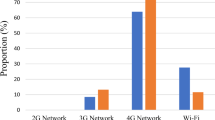Abstract
When moving around, mobile phones in stand-by mode periodically send data about their positions. The aim of this paper is to evaluate how personal radiofrequency electromagnetic field (RF-EMF) measurements are affected by such location updates. Exposure from a mobile phone handset (uplink) was measured during commuting by using a randomized cross-over study with three different scenarios: disabled mobile phone (reference), an activated dual-band phone and a quad-band phone. In the reference scenario, uplink exposure was highest during train rides (1.19 mW/m2) and lowest during car rides in rural areas (0.001 mW/m2). In public transports, the impact of one’s own mobile phone on personal RF-EMF measurements was not observable because of high background uplink radiation from other people’s mobile phone. In a car, uplink exposure with an activated phone was orders of magnitude higher compared with the reference scenario. This study demonstrates that personal RF-EMF exposure is affected by one’s own mobile phone in stand-by mode because of its regular location update. Further dosimetric studies should quantify the contribution of location updates to the total RF-EMF exposure in order to clarify whether the duration of mobile phone use, the most common exposure surrogate in the epidemiological RF-EMF research, is actually an adequate exposure proxy.
This is a preview of subscription content, access via your institution
Access options
Subscribe to this journal
Receive 6 print issues and online access
$259.00 per year
only $43.17 per issue
Buy this article
- Purchase on Springer Link
- Instant access to full article PDF
Prices may be subject to local taxes which are calculated during checkout



Similar content being viewed by others
References
Röösli M, Frei P, Bolte J, Neubauer G, Cardis E, Feychting M et al Conduct of a personal radiofrequency electromagnetic field measurement study: proposed study protocol. Environ Health 2010; 9 (1): 23.
Viel JF, Cardis E, Moissonnier M, de Seze R, Hours M . Radiofrequency exposure in the French general population: band, time, location and activity variability. Environ Int 2009; 35 (8): 1150–1154.
Bolte JF, van der Zande G, Kamer J . Calibration and uncertainties in personal exposure measurements of radiofrequency electromagnetic fields. Bioelectromagnetics 2011; 32 (8): 652–653.
Thuróczy G, Molnar F, Jánossy G, Nagy N, Kubinyi G, Bakos J et al Personal RF exposimetry in urban area. Ann Telecommun 2008; 63 (1-2): 87–96.
Joseph W, Vermeeren G, Verloock L, Heredia MM, Martens L . Characterization of personal RF electromagnetic field exposure and actual absorption for the general public. Health Phys 2008; 95 (3): 317–330.
Frei P, Mohler E, Bürgi A, Fröhlich J, Neubauer G, Braun-Fahrländer C et al Classification of personal exposure to radio frequency electromagnetic fields (RF-EMF) for epidemiological research: Evaluation of different exposure assessment methods. Environ Int 2010; 36 (7): 714–720.
Lin YB, Lee PC, Chlamtac I . Dynamic periodic location update in mobile networks. IEEE Trans Vehicular Technol 2002; 51: 615–624.
Joseph W, Frei P, Röösli M, Thuróczy G, Gajsek P, Trcek T et al Comparison of personal radio frequency electromagnetic field exposure in different urban areas across Europe. Environ Res 2010; 110 (7): 658–663.
Frei P, Mohler E, Neubauer G, Theis G, Bürgi A, Fröhlich J et al Temporal and spatial variability of personal exposure to radio frequency electromagnetic fields. Environ Res 2009; 109 (6): 779–785.
Röösli M, Frei P, Mohler E, Braun-Fahrländer C, Bürgi A, Fröhlich J et al Statistical analysis of personal radiofrequency electromagnetic field measurements with nondetects. Bioelectromagnetics 2008; 29 (6): 471–478.
Vrijheid M, Mann S, Vecchia P, Wiart J, Taki M, Ardoino L et al Determinants of mobile phone output power in a multinational study: implications for exposure assessment. Occup Environ Med 2009; 66 (10): 664–71.
Cooke R, Laing S, Swerdlow AJ . A case–control study of risk of leukaemia in relation to mobile phone use. Br J Cancer 2010; 103 (11): 1729–1735.
Divan HA, Kheifets L, Obel C, Olsen J . Prenatal and postnatal exposure to cell phone use and behavioral problems in children. Epidemiology 2008; 19 (4): 523–529.
Vrijheid M, Martinez D, Forns J, Guxens M, Julvez J, Ferrer M et al Prenatal exposure to cell phone use and neurodevelopment at 14 months. Epidemiology 2010; 21 (2): 259–262.
Baumann J, Landstorfer FM, Geisbusch L, Georg R . Evaluation of radiation exposure by UMTS mobile phones. Electron Lett 2006; 42 (4): 225–226.
Author information
Authors and Affiliations
Corresponding author
Ethics declarations
Competing interests
The authors declare no conflict of interest.
Additional information
Supplementary Information accompanies the paper on the Journal of Exposure Science and Environmental Epidemiology website
Supplementary information
Rights and permissions
About this article
Cite this article
Urbinello, D., Röösli, M. Impact of one’s own mobile phone in stand-by mode on personal radiofrequency electromagnetic field exposure. J Expo Sci Environ Epidemiol 23, 545–548 (2013). https://doi.org/10.1038/jes.2012.97
Received:
Accepted:
Published:
Issue Date:
DOI: https://doi.org/10.1038/jes.2012.97
Keywords
This article is cited by
-
Radiofrequency electromagnetic field exposure in everyday microenvironments in Europe: A systematic literature review
Journal of Exposure Science & Environmental Epidemiology (2018)
-
Radiofrequency-electromagnetic field exposures in kindergarten children
Journal of Exposure Science & Environmental Epidemiology (2017)
-
Instruments to assess and measure personal and environmental radiofrequency-electromagnetic field exposures
Australasian Physical & Engineering Sciences in Medicine (2016)



